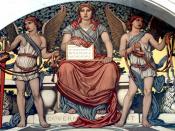Fiscal policy is the second tool available for use by the government (it is used by the government at all levels). The term fiscal policy refers to the expenditure the government undertakes to provide goods and services and to the way in which the government finances these expenditures.
There are two methods of financing: borrowing and taxation. The debt burden assumed by the government is itself an important policy variable and one that has implications for the conduct of monetary policy. Our government acts on many different, occasionally conflicting objectives. It may want to smooth out the nation's income in order to minimize the negative effects of the business cycle or it may want to take steps designed to increase the national income. Taxation takes many forms including taxation of personal and corporate income, so-called value added taxation and the collection of royalties or taxes on specific sets of goods.
Additionally, there are two types of expenditures: money spent on the delivery of goods and services and the transfer of funds to other levels of government. When the government spends large amounts of money it has a stimulating effect on the economy. The government is large enough that it can spend during periods of economic contraction thereby helping to prop up both the economy and consumer confidence. This school of thought in which the government plays an active role in stimulating the economy in times of recession and in easing their spending in times of success is called the Keynesian School, after the economist John Maynard Keynes. Keynes formulated his theories during the Great Depression as governments in Europe and the United States struggled to restore their troubled economies by restricting credit in the economy. By the 1960's it was widely agreed that fiscal policies should be used to...


